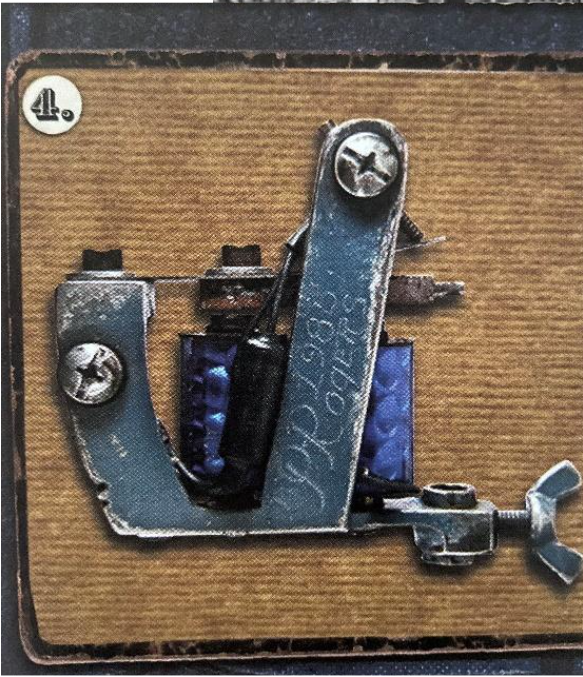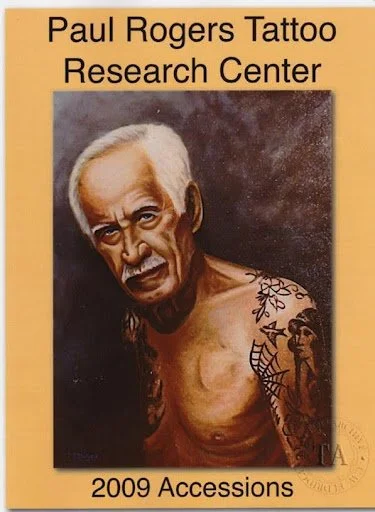Paul Rogers
The Father of American Tattooing, Franklin Paul Rogers was born on September 9th 1905 in a log cabin in the woods of North Carolina, where life for many was rough. Back then there were no automobiles, so horse drawn wagons were used. His family moved frequently for work and had to move from mill to mill to make money and feed the family. Paul’s father died when he was a young boy. He was a timber cutter, and he fell into the river during the winter and died from hypothermia. Paul began working in the mills when he was 13 years old and worked side by side with grown men, doing the same amount of work at such a young age. Child labor laws hadn’t been enacted yet. Paul didn’t care too much about school and decided to quit going altogether and continue working full-time.
The story goes, Paul had seen a calendar on the wall at his aunt’s house, and he had a love for calendars ever since and kept daily records of events which is how we know so much about his life today, not including the written and recorded interviews.
Paul spent 7 long hard years living with his grandfather on his farm. He would play in the woods, hunt, and fish with his brother. Paul really loved the woods and loved living there. A man who had worked for his grandfather had a tattoo on his arm that he had gotten in the army. Paul saw this and became interested in tattoos and they stayed in the back of his mind for a long time.
In 1926, he got his first tattoo from a traveling tattoo artist in the circus by the name of Chet Cain. This is where Paul first heard about Cap Coleman and his famous machines. He got tattooed by Chet Cain for 3 years in a row. Before that he had only known of tattoos from the man that worked for his grandfather and a guy his sister knew who had been in the Navy. Over that time, Cain had given him tips and tricks about tattooing and told him where he could purchase machines and supplies for the trade. He bought a tattoo kit in 1928 from E.J. Miller out of Norfolk, Virginia. He first tattooed himself October 11, 1928. He started out with the J.J. Page show in an old Model T. He bought a tent, a cook stove, and a folding cot for travel. He had a baby blue Tattoo trunk with matching folding chairs and a table where he would work out of his tent. He spent a lot of time traveling with and visiting circuses over time that he eventually taught himself how to do acrobatics and would often show off his hand standing skills in the most daring ways he could manage. He also had a set of special chairs built that he would use for his balancing act.
Paul joined the team at John T. Rhea Sideshow where he met a girl named Helen. Helen had a boyfriend at the time but that didn’t stop Paul from admiring her beauty. Her boyfriend left the show to work, and this gave Paul and Helen more time together. They spent time visiting local swimming holes and driving around in his model T. Needless to say, Paul and Helen ended up together and who knows what the heck happened to her ex-boyfriend!
They were married on October 14th, 1933, during the Great Depression. They both began working at the Mills and Helen became pregnant. Their son Leonard was born a year later October 16th, 1934. Then their second son Willis was born April 6th, 1937, while they were traveling on the road. As most tattooers do, Paul and his family would travel all around in a trailer, working the mills in the winter and the Carnivals in the summer. Paul tattooed here and there as they travelled and eventually Paul made his way over to Cap Coleman.
Coleman had seen his work on a sailor he was tattooing after he mistakenly took credit for one of the ships that had been done on him. You see, Paul had used some of Colemans flash and he did it so well that he immediately impressed the old man. Soon enough, Cap Coleman was writing to Paul asking him to come and work with him after the war was over. Paul hopped on a train and headed to Coleman where he was only supposed to stay for the weekend. He ended up staying 6 whole weeks, sleeping in the tattoo shop and eating out every night, before he went back home.
This was a dream come true for Paul because he was a hero to the young man. He and Coleman began a 5-year relationship and Paul spent his time there tattooing the sailors that would frequently walk in. Although he admired Colemans legendary status and was happy to have learned so much from the old man, he had very mixed feelings about his personality stating that “He was a very selfish guy” and that “He hated people”. Nevertheless, he learned more from Coleman about tattooing and machines than he had since he began his career. Everything before was just trial and error until he got it right. Coleman would save money by claiming that he couldn’t use brown or green in a tattoo if they had been vaccinated and said it would make them sick. So, for a long time, he got away with using only black and red ink and this ultimately became known as the classic American style tattooing that was popular in the 1920s and 1940s.
While Paul was working for Cap Coleman, he learned quite a bit about tattoo machines and would fix and tune the machines for all the tattooers working in Norfolk. He said “There were 11 at one point and you could count the good ones on three fingers. He had learned much from Cap Coleman about machines, but there was another man who heavily influenced Paul and that was Charlie Barrs.
As some of you may know, Charlie Barrs is the man who taught Cap Coleman about tattoo machines. Coleman met Barrs when he was 72 and semiretired. The two had a wonderful relationship and Paul learned everything he could from the old man. He even credits his style of machine assembly and tuning to him. They remained good friends and correspondents to one another until they lost touch and Barrs letters stopped coming. Barrs death date is unknown, but the letters stopped coming in 1960.
When Norfolk suddenly banned tattooing, this left Paul and all the other tattooers in a real pickle and it forced most of them to move across the river to Portsmouth. Fortunately, Paul had planned with his fellow tattooer and good friend R.L. Connely to start a partnership and open shops in Petersburg, Virginia, and Jacksonville, North Carolina. The pair would travel back and forth between the shops, 4 days on, 4 days off. Over time, Paul eventually took over the Jacksonville shop and here is where he met Huck Spalding who tattooed and had an animal show. Connely and Paul were losing their shop location. They had decided to build doctors’ offices there instead. Spaulding had a great location and Connely, who was also a cabinet maker, had decided he wanted to retire from tattooing, so this gave Paul the chance to move on with Spaulding to his shop at 713 Court Street in Jacksonville, Florida. Spaulding and Rogers was born. Because Spaulding wasn’t as fast or as talented as Paul, he really needed someone to help with the overflow of men from the Special Forces. Life was good for Rogers. He bought a home that he and his wife adored and was getting plenty of business. Specifically, from tattooers needing machine repairs. They started their mail order tattoo supply business, Spaulding and Rogers, and everything they sold was of the highest quality, which set them apart from others. Famous tattooer of today have all gotten their start with Spaulding and Rogers supplies and they continue to be the popular choice for supplies to artists from all over.
As it always seems to go, Jacksonville decided they would be the next to ban tattooing. One-month long visit in Alaska, and then back again to Jacksonville, Huck and Paul came cruising back to work. And business was still pretty good. But he was restless and moved to work with Bill Williamson for a little while. He and his wife bought a mobile home, settled down, and Paul made a decision that would launch him into tattoo history. Paul loved tattooing, but what he loved the most was building and repairing tattoo machines, and he knew that he wanted to spend the rest of his time doing the thing that he loved. In a portable 12x12 tin shack behind his home he built the legendary “Iron Factory’. The best that have ever been made have come out of his tin shack making non-flattering but dependable and hard-working machines. Paul was the first to use the term “irons’ for his machines and it officially stuck. He used hand tools to perfect his machines and machine heads from all over the world would pilgrimage to his Iron Factory just to catch a glimpse and maybe even gain some knowledge from the best in the business. Even Ed Hardy raved about the impact that Paul had on tattooing and how his machines defined and developed the way tattoos are done today.
In the 1970s, Paul befriended C.W Eldridge, a fellow tattooer and documentarian. They spent many hours, many days, many years together. Eldridge interviewed him for the autobiography they were going to write together but Paul passed away before they finished. In 1988, Paul suffered a stroke and was rushed to the hospital and was paralyzed on his right side which prevented him from speaking. He spent 2 years in a nursing home before he passed away at the age of 84.
In 1993, several infamous tattooers got together and started the Paul Rogers Tattoo Center. They include Chuck Eldridge, Ed Hardy, Alan Govenar, and Henk Schiffmacher, better known as “Hanky Panky’. The organization has Paul’s entire collection of tattoo memorabilia, flash, and photographs. The goal of the organization is to preserve and share tattoo history with the entire world. The PRTC is in The Tattoo Archive Store in Winston-Salem NC. There you can purchase books, view memorabilia, and even get a tattoo since it’s also a running tattoo shop.
Paul Rogers was one of the largest influences in modern tattoo history and all the best and greatest artists of our time owe everything to his wisdom and knowledge. He continues to be an influence today for young and old artists alike. Some have known his story, and some are just now discovering who he is, but either way, he is the Father of American Tattooing.






